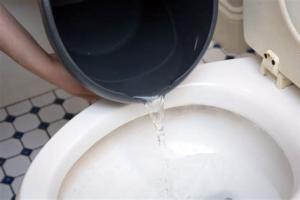Ultimate Guide: How to Empty a Toilet Bowl for Cleaning, Repair, or Removal

-
Quick Links:
- Introduction
- Why Empty a Toilet Bowl?
- Tools and Materials Needed
- Step-by-Step Guide to Empty a Toilet Bowl
- Case Studies and Real-World Applications
- Expert Insights
- Safety Tips
- FAQs
Introduction
Emptying a toilet bowl is a task that many homeowners might face at some point, whether for cleaning, repairs, or removal. It can seem daunting, but with the right tools and techniques, it can be a straightforward process. In this comprehensive guide, we'll cover everything you need to know about safely and effectively emptying a toilet bowl, including the necessary tools, step-by-step instructions, and expert insights.
Why Empty a Toilet Bowl?
Understanding the reasons behind emptying a toilet bowl is essential. There are various scenarios where this might be necessary:
- Cleaning: Regular maintenance helps prevent stains and odors.
- Repairs: Issues like clogs or leaks may require access to the toilet's internal components.
- Removal: If you're replacing or removing the toilet entirely, it must be emptied first.
Tools and Materials Needed
Before you start, gather the following tools and materials:
- Bucket
- Wet/dry vacuum (optional)
- Plunger
- Sponges or towels
- Gloves
- Adjustable wrench
- Toilet auger (if needed)
Step-by-Step Guide to Empty a Toilet Bowl
Follow these detailed steps to empty your toilet bowl effectively:
Step 1: Prepare the Area
Ensure the area around the toilet is clear and that you have access to all necessary tools. Put on gloves for protection.
Step 2: Shut Off the Water Supply
Locate the shut-off valve behind the toilet and turn it clockwise to close it. This prevents any water from entering the tank while you work.
Step 3: Flush the Toilet
Flush the toilet to remove as much water as possible. This will help reduce the amount of water you need to remove manually.
Step 4: Remove Remaining Water
Using a sponge or towel, soak up any remaining water in the bowl. Alternatively, you can use a wet/dry vacuum for faster removal. Ensure that you dispose of the water properly.
Step 5: Disconnect the Toilet (if necessary)
If you need to remove the toilet completely, disconnect the water supply line using an adjustable wrench. Be prepared for any residual water to spill out when you disconnect the line.
Step 6: Inspect for Damage
Before reinstalling or replacing, inspect the flange and wax seal for any damage. Replace if necessary.
Case Studies and Real-World Applications
Let's explore a few case studies that highlight the importance of knowing how to empty a toilet bowl:
Case Study 1: Routine Maintenance
A homeowner regularly cleans their toilet every month. By following proper techniques to empty the bowl, they prevent hard water stains and keep the toilet fresh.
Case Study 2: Emergency Repairs
When a toilet began to leak, the homeowner was able to quickly empty the bowl and remove the toilet, saving themselves from extensive water damage.
Expert Insights
We consulted plumbing experts to gather insights on the best practices for emptying a toilet bowl:
Expert Tip: “Always wear gloves and ensure the area is well-ventilated when working on a toilet. If you're uncertain about disconnecting the toilet, consult a professional.”
Safety Tips
When dealing with plumbing tasks, safety should always be a priority. Here are some tips:
- Always wear gloves to protect your hands from bacteria.
- Use a face mask if you're sensitive to odors.
- Have a first aid kit close by in case of minor injuries.
FAQs
Here are some common questions and answers regarding emptying a toilet bowl:
- 1. Can I use bleach to clean the toilet after emptying it?
- Yes, but ensure the toilet is completely empty and avoid mixing bleach with other cleaning agents.
- 2. What if my toilet won’t flush?
- You might need to check for clogs or issues with the flushing mechanism. An auger can help with this.
- 3. How often should I empty my toilet bowl for cleaning?
- It’s recommended to clean and empty the bowl at least once a month for maintenance.
- 4. Is it safe to remove a toilet on my own?
- Yes, but be cautious when handling plumbing parts. If unsure, consult a professional.
- 5. How do I know if my toilet needs a new wax seal?
- If you notice leaks around the base or movement when you sit on it, it may be time for a replacement.
- 6. Can I use a garden hose to refill the tank?
- Yes, but ensure the hose is clean and free of contaminants before use.
- 7. What tools do I need for minor toilet repairs?
- Basic tools include a wrench, screwdriver, and plunger.
- 8. How do I handle a clogged toilet?
- A plunger or toilet auger can typically resolve clogs. If persistent, consult a plumber.
- 9. What should I do if water spills during the process?
- Quickly soak up the water with towels and ensure you disinfect the area afterward.
- 10. Can I hire a plumber to do this?
- Absolutely, if you’re uncomfortable doing it yourself, hiring a professional is a safe option.
Random Reads
- How to unclog a toilet without a plunger
- Change macbook pro battery
- Change microsoft office product key
- How to add another language to your keyboard
- How to switch from aol to gmail
- Easy ways enable file sharing network
- How to fix ps3 controllers
- How to fix orange peel without sanding
- How to install a motherboard
- How to install a built in dishwasher